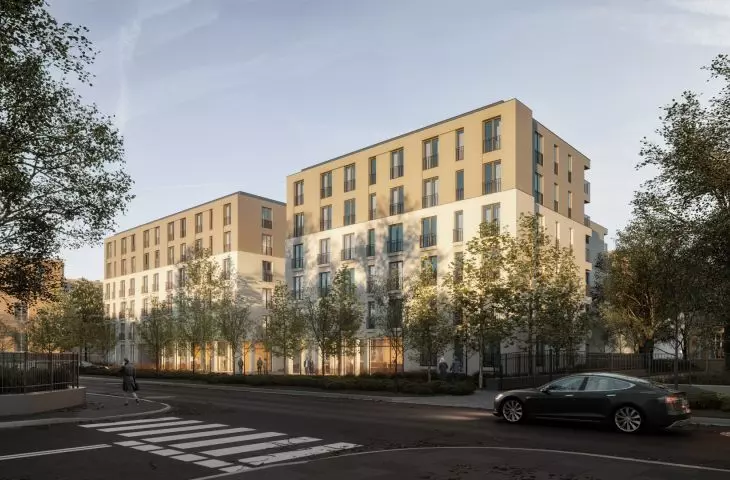The Poznan investment of the Housing for Rent Fund has outraged the architectural community. "Architecture of the highest order," the head of the Municipal Urban Planning and Architectural Commission ironically says, and "congratulates" the supervision of the city's historic preservationist. For, although the new buildings will stand in an important but much-neglected location, their form and layout are far from the quality due to this location.
When can an investment in an important location have a level that is inadequate to the stature of the place? It's simple. First the place must be condemned to oblivion, then brought to a terrible state, and then sold to an investor who, yes, will restore the area to the city, but with a very mediocre project. Probably, the joy of eliminating a spatial sub-standard makes decision-makers forgive the pressure on the investor regarding the historical and spatial values of the place. And this is true even when - in theory - the historic preservationist has a lot to say.
One such case is the fresh example of a new residential enclave between Poznań's Śniadeckich and Święcickiego streets, which is being erected by the state-owned Fund for Housing for Rent (FMnW). This is the Fund's first construction project in the city. It previously offered its apartments in buildings bought from developers in three other locations.
between students
This time, construction started on a special site - between two grand buildings of the Medical University: Collegium Anatomicum and Collegium Heliodori Swiecicki (formerly: Chemicum). Both were completed in 1929 (designed by Edward Madurowicz, Roger Slawski). They first functioned as exhibition venues for the Universal National Exhibition (PWK): Government Palace and Palace of Art. After the exposition ended, they ended up in the hands of the University of Poznan. The spacious space between them was carefully arranged as the Art Garden, where sculptures, including a model of the Warsaw Aviator Monument by Edward Wittig, were displayed during the PWK (archival photos: here).
Housing project of the Housing for Rent Fund on Śniadeckich Street in Poznań. Condition before construction
investor materials
After the war, the former garden mostly served as an off-road reserve of the nearby Poznań International Fair, which was struggling with a lack of space in its area. In recent decades, degraded, neglected and forgotten, it served primarily as a parking lot. Until recently, the site belonged to the University, which tried unsuccessfully to develop a convention center or retail and service building. It later sold the site to the Fund, which - based on development warrants (no mpzp) - is now erecting five six-story residential buildings here with 318 apartments (from studios to four-room apartments ) and services on the first floor. The Design Initiative studio is responsible for the project. However, the very economical and monotonous form of the buildings is out of step with the historic academic buildings maintained in a historicizing style, and insufficient care has been taken to integrate it carefully among the university buildings.
Housing project of the Housing for Rent Fund at Sniadeckich Street in Poznań. Visualization. Proj.: Inicjatywa Projektowa
investor materials
conservator to the board!
The project was already presented two years ago, but construction started late this year and sparked heated criticism. A week ago, architect Bartosz Małecki, chairman of the Municipal Urban Planning and Architectural Commission, spoke out on Facebook . Under an image showing the area's pre-war condition, he wrote:
The construction of a housing development in the area below has just begun. I would like to thank the MKZ for its commitment and care for the quality of space in the historic St. Lazarus neighborhood. Architecture of the highest order.
The topic was picked up by the local "Gazeta Wyborcza, " quoting both critical voices - including Małecki's, the head of Poznań's SARP - Wojciech Krawczuk, and one of his predecessors - Andrzej Kurzawski - as well as the official position of the City Hall's Department of Urban Planning and Architecture and, most significantly, the Office of the Municipal Conservator of Monuments. The preservationists report laconically thatthey have made comments regarding the subordination of the investment to the axial premise of the two academic edifices. However, nothing is known about other requirements - concerning detailed material solutions or related to the shape of the massing or attempts to block the development of a valuable area. This is quite astonishing when one has knowledge of the sometimes very detailed and not always legitimate restrictions placed by the MKZ Office on other designers and investments. In recent years, Poznań conservator Joanna Bielawska-Pałczyńska has even resisted the replacement of paving blocks in the Old Market Square by refusing to agree to grinding down the "historic" stones (while failing to present expert reports that prove the harmfulness of such a procedure).
Housing project of the Housing for Rent Fund on Śniadeckich Street in Poznań. Visualization. Current state of work. In the background the building of Collegium Anatomicum
photo: Jakub Głaz
there is something to talk about
Poznan conservators, by the way, are no exception. The media, including A&B, sometimes report on the great discretion of preservation services and sometimes very contradictory attitudes towards similar spatial and architectural problems (depending on the preservationist and the center where he works). Recently there has been a lot of publicity about theblocking of the greening of Trzech Krzyży Square in Warsaw by the provincial conservator of monuments Jakub Lewicki, despite the recommendations that the then General Conservator of Monuments, Magdalena Gawin, made ongreenery issues last year. It is high time, therefore, for a serious nationwide discussion of what should be changed in the conservators' actions, and to clarify the scope of their activities when agreeing with architects.





































